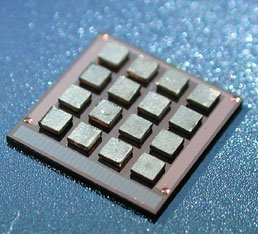Radioactive Detector
 Silicon chip built with 16 tiny gamma ray detectors may help nuclear inspectors improve analysis of plutonium and other radioactive materials. Each detector is one millimeter square.
Silicon chip built with 16 tiny gamma ray detectors may help nuclear inspectors improve analysis of plutonium and other radioactive materials. Each detector is one millimeter square.[photo courtsey: NIST]
Emissions from radioactive materials such as uranium or plutonium provide unique signatures that, if accurately measured, can indicate the age and enrichment of the material and sometimes its intended purpose or origin.
Scientists at the Commerce Department’s National Institute of Standards and Technology (NIST) have designed and demonstrated the world’s most accurate gamma ray detector, which is expected to be useful eventually in verifying inventories of nuclear materials and detecting radioactive contamination in the environment.
The tiny prototype detector, described last week at the American Physical Society national meeting in Baltimore, can pinpoint gamma ray emission signatures of specific atoms with 10 times the precision of the best conventional sensors used to examine stockpiles of nuclear materials. The NIST tests, performed with different forms of plutonium at Los Alamos National Laboratory, also show the prototype greatly clarifies the complex X-ray and gamma-ray emissions profile of plutonium.
The 1-square-millimeter (mm) prototype collects only a small amount of radiation, but NIST and Los Alamos researchers are collaborating to make a 100-sensor array that could be deployed in the field, perhaps mounted on a cart or in a vehicle.

0 Comments:
Post a Comment